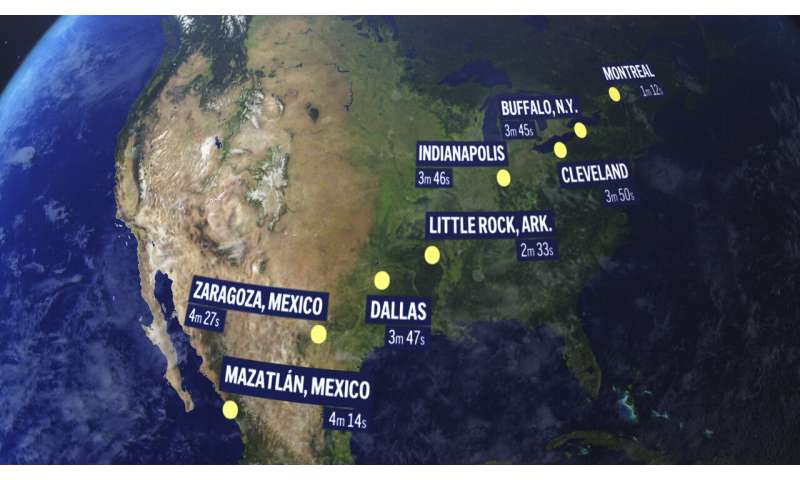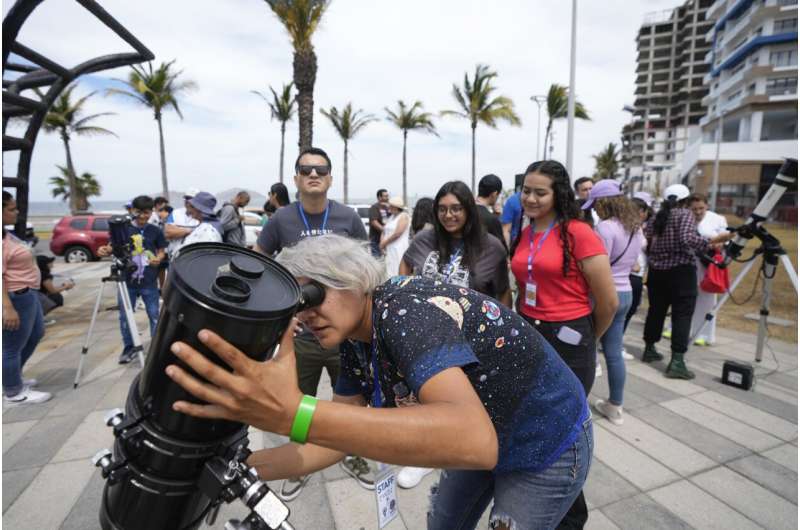"At the very least, it won't snow."
The cliff-hanging uncertainty added to the drama. Rain or shine, "it's just about sharing the experience with other people," said Chris Lomas from Gotham, England, who was staying at a sold-out trailer resort outside Dallas, the biggest city in totality's path.
For Monday's full eclipse, the moon was due to slip right in front of the sun, entirely blocking it. The resulting twilight, with only the sun's outer atmosphere or corona visible, would be long enough for birds and other animals to fall silent, and for planets, stars and maybe even a comet to pop out.

The out-of-sync darkness lasts up to 4 minutes, 28 seconds. That's almost twice as long as it was during the U.S. coast-to-coast eclipse seven years ago because the moon is closer to Earth. It will be another 21 years before the U.S. sees another total solar eclipse on this scale.
Extending five hours from the first bite out of the sun to the last, Monday's eclipse begins in the Pacific and makes landfall at Mazatlan, Mexico, before moving into Texas, Oklahoma, Arkansas and 12 other U.S. states in the Midwest, Middle Atlantic and New England, and then Canada. Last stop: Newfoundland, with the eclipse ending in the North Atlantic.
It will take just 1 hour, 40 minutes for the moon's shadow to race more than 4,000 miles (6,500 kilometers) across the continent.
Eye protection is needed with proper eclipse glasses and filters to look at the sun, except when it ducks completely out of sight during an eclipse.

People take a photo at Lake Ontario Park, an official eclipse viewing location, a day before a total solar eclipse will be visible in Kingston, Ontario, Sunday, April 7, 2024. Credit: Justin Tang/The Canadian Press via AP 
Gabriel Kauffman, 4, and his brother, Theodore, 6, demonstrate a total solar eclipse at a NASA booth at the Great Lakes Science Center in Cleveland, on Sunday, April 7, 2024. They live in Baltimore and came to the Cleveland area to see the eclipse with relatives. Credit: AP Photo/Stephanie Nano 
Un eclipse solar total el 8 de abril ingresará al continente americano por la costa mexicana del Pacífico, avanzará hacia el norte a través de Texas y Oklahoma, cruzará la región centro-norte de Estados Unidos, la región central con litoral en el Atlántico, y Nueva Inglaterra, antes de salir a través del este de Canadá hacia el Atlántico. Credit: AP Foto, archivo
The path of totality—approximately 115 miles (185 kilometers) wide—encompasses several major cities this time, including Dallas, Indianapolis, Cleveland, Buffalo, New York and Montreal. An estimated 44 million people live within the track, with a couple hundred million more within 200 miles (320 kilometers). Add in all the eclipse chasers, amateur astronomers, scientists and just plain curious, and it's no wonder the hotels and flights are sold out and the roads jammed.
Experts from NASA and scores of universities are posted along the route, poised to launch research rockets and weather balloons, and conduct experiments. The International Space Station's seven astronauts also will be on the lookout, 270 miles (435 kilometers) up.
© 2024 The Associated Press. All rights reserved. This material may not be published, broadcast, rewritten or redistributed without permission.



